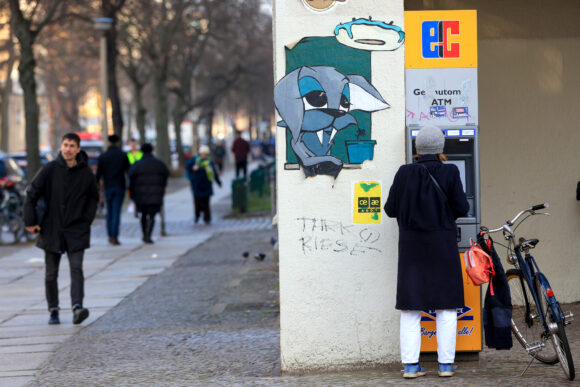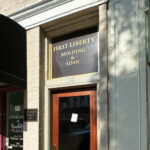In the early morning hours of May 6, 2023, an explosion occurred in a bank in the German town of Bad Homburg, sending shattered glass as far as 30 meters away. Two men had broken into the building and filled the ATM with explosives. Once the device did its job, they grabbed €165,000 in cash, jumped into the waiting getaway car and rushed off into the night.
The theft took just a couple of minutes.
Almost every day — or usually, every night — an ATM is blown up somewhere in Germany. Europe’s biggest economy has become the prime target for sophisticated smash-and-grab operations by organized criminal groups. Very few people rob banks anymore, it’s not worth it. ATM bombings are quicker, less risky and the payouts are significantly higher.
The Federal Criminal Police Office has been monitoring this type of crime since 2005, when numbers started to rise across Europe. Ten years later, they skyrocketed in Germany. Attacks doubled in 2016 to 318, and peaked in 2022, when 496 ATMs were blown up.
Thieves Blow Up German ATMs Every Day, With Attacks Rising 40%-Plus Since 2019
“We see ATM blasts all over the world, but the intensity that we experience in Germany is really in a league of its own,” said Stefan Lessmann, head of security at ATM-maker Diebold Nixdorf, the market leader for the machines in the EU.
The reasons behind this are simple: Germany borders the Netherlands, which is home to the Amsterdam and Utrecht-based networks that orchestrate most of the attacks. The Netherlands had previously been the epicenter of these bombings, but by 2015, the Dutch had reduced the number of ATMs nationally from 20,000 to 5,000, fortified the remaining ones, and encouraged businesses and residents to wean themselves off cash.
With few targets left in their home county, the perpetrators went east: to Germany.
What they found was a paradise for ATM bombers. There are more than 50,000 ATMs in the country, and as the national central bank put it in a January report, “cash has a special social significance.” According to a 2023 Bundesbank study, the vast majority of Germany’s 83.3 million inhabitants live within a kilometer of an ATM. Additionally, the country’s extensive national highway network gives attackers an easy way to escape.
Germany’s decentralization also works in criminals’ favor: unlike the Netherlands, which has only four banks, Germany has a more diverse sector, including hundreds of independent savings and loan banks. Moreover, each of the country’s 16 states also has its own police force, making coordination a challenge.
Achim Schmitz leads the central police unit focusing on ATM bombings in North-Rhine Westphalia, the first German state to be targeted a decade ago. Schmitz and his colleagues have arrested hundreds of suspects and won stiff prison sentences over the years, but that hasn’t gotten the attacks to stop.
“In 2015, we initially thought there was a ring of perpetrators and once we caught the core people, we would get rid of the problem,” said Schmitz. “We had to give up on that hypothesis a long, long time ago.”
Instead, Schmitz and his unit have witnessed a seemingly never-ending supply of young men trained to work in highly specialized teams, most of whom are Dutch nationals of Moroccan descent.
Last month, the German government announced plans to raise prison terms for the bombings to a minimum of two and a maximum of 15 years and to expand police surveillance powers around the attacks. As prosecutors try various ways to discourage would-be bombers — including charging some with attempted murder in addition to aggravated theft — there has been grumbling within law enforcement about whether banks are doing enough to prevent this sort of crime.
In 2022, Germany’s interior ministry assembled representatives from the federal and state police, financial sector, insurance companies and the country’s central bank to discuss what to do about the attacks. The so-called “round table” agreed on recommended steps — such as equipping ATMs with defensive technologies and removing them from high-risk areas — but stopped short of making these measures mandatory.
Official data for 2023 has not yet been published, but preliminary counts suggest that numbers have been continuously falling. The ministry revisit the effort in 2025 to gauge its success.
For its part, Germany’s financial industry says members have spent more than €300 million in recent years on security measures such as installing alarm systems and defensive technologies, locking ATM foyers at night and simply filling machines with less money. Still, banks remain trapped in a sort of arms race with organized crime.
When ATM foyers were equipped with fogging systems — which quickly fill a room with dense smoke in the event of an attack — gangs started bringing in leaf blowers. When ATMs were fortified to make them more difficult to blow up, perpetrators doubled their efforts and switched from gas explosives to solid pyrotechnic materials. On balance, Germany’s Federal Criminal Police Office estimates that the success rate for these attacks is now about 60% percent.
“We don’t know what tactics these perpetrators will come up with tomorrow,” Lessmann said. “We can’t develop machines that are 100% safe — there are limits, both physically and in terms of costs.”
Anti-theft solutions can also create their own problems. Ink-staining technologies, which Lessman described as “the most widely used method globally” to prevent attacks, contain chemicals that the Bundesbank says are impossible to wash out, making bills unusable after they’ve been tinted. Newer banknote-gluing systems present a similar problem. Germany’s central bank will reimburse lenders for both stained and glued banknotes, though it charges a fee if they were destroyed because of a false trigger – which is the case for the vast majority of reimbursement submissions, according to Bundesbank. In 2023, lenders submitted about 500,000 notes that were stained due to false alarms. The Bundesbank declined to disclose how much they were worth.
Ultimately, there’s no perfect way to protect an ATM. Lenders have fortified their systems, built outdoor pavilions to host their machines and installed so-called “rear-feeders” which distribute cash to the machines through a wall connected to a back room. Yet attackers continue to strike, causing some banks to close certain branches for good. Landlords aren’t eager to rent to banks with ATMs, especially when there are apartments in same building.
“Removing ATMs may be the last resort,” DGSV, a bank lobbying group, said of preventing such attacks. “This is certainly not popular, but there’s no alternative if there’s a risk to life and limb.”
In the nine years since bombings became a serious problem, the German states of North Rhine-Westphalia, Hesse and Lower Saxony, which were initially hit the hardest, have managed to clamp down on the attacks. All credit their success to a combination of measures: the use of digital tools that enable them to track perpetrators in near real-time, closer cooperation with the Dutch police, convincing banks to adopt the round-table recommendations, and categorizing individual ATMs according to risk levels.
These efforts have forced bombers south, to the German states of Bavaria and Baden-Wuerttemberg, and even into Austria and Switzerland. In recent months, the area around Basel has experienced a wave of attacks.
Jens Burrichter has worked on ATM-bombing cases for the Lower Saxony police since 2015. For two years, he served at Europol, organizing conferences and coordinating cross-border communication to make sure police across Europe were working together to prevent attacks.
Like many of his peers, Burrichter is certain that Germany needs to learn from the Netherlands and drastically reduce its number of ATMs and overall use of cash. But he also knows that no one will win an election in Germany by campaigning on the end of ATMs.
“We won’t be able to change everything,” said Burrichter. “My father is 70, he won’t switch to a card to pay for bread at the bakery.”
Photograph: Almost every day, an organized criminal group blows up an ATM somewhere in Germany. Photo credit: Krisztian Bocsi/Bloomberg
Topics Europe
Was this article valuable?
Here are more articles you may enjoy.



 Son of Ponzi-Accused Georgia Building & Loan Founder Now an Insurance Agent
Son of Ponzi-Accused Georgia Building & Loan Founder Now an Insurance Agent  Aon Adds to List of Brokers Suing Howden US for Alleged Poaching, Theft
Aon Adds to List of Brokers Suing Howden US for Alleged Poaching, Theft  Viewpoint: Artificial Intelligence Is Rewriting the Rules for Commercial Lines
Viewpoint: Artificial Intelligence Is Rewriting the Rules for Commercial Lines  Twice Injured Firefighter Loses Second Workers’ Compensation Claim
Twice Injured Firefighter Loses Second Workers’ Compensation Claim 

